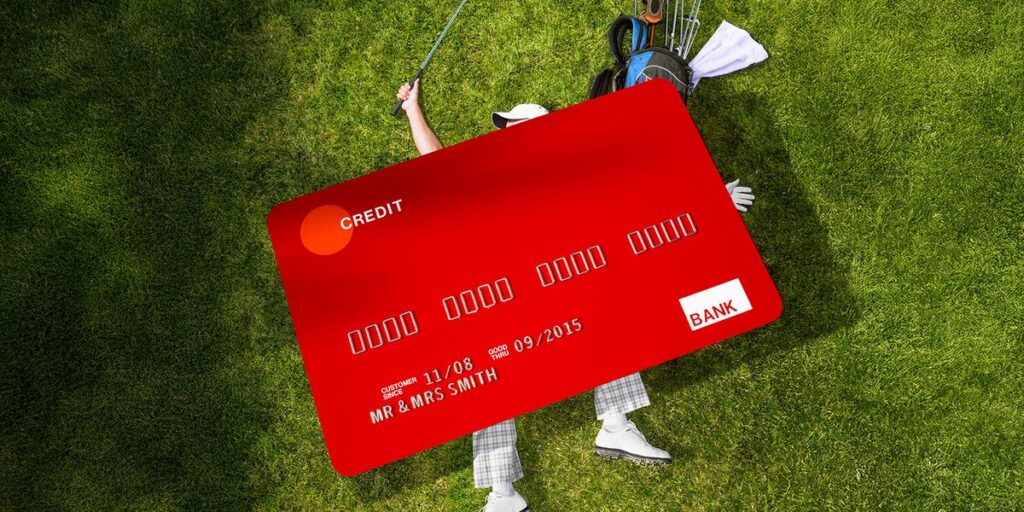For a certain subset of Americans, credit card rewards make the world go around.
The cottage industry around credit cards and their requisite rewards is centered on a tantalizing prospect: You spend money to make money. And, if you play the game right, you can secure perks you’d never otherwise afford. I’ve spoken to younger credit card holders who have found themselves in luxury layback seats on planes or in fancy airport lounges. Some lucky Capital One cardholders were able to get presale tickets for Taylor Swift’s Eras tour. Other payouts are more quotidian: A friend was recently delighted to learn that her credit card was offering 10% back at Olive Garden, where we enjoyed a celebratory meal.
I’m guilty of gamifying my spending. I’ve strategized when and where to buy groceries or which card to use at the laundromat to get more points. The payoff has been pretty great: I don’t know if I’ve paid for a flight in years, and I’ve skipped lines at music festivals with my Chase card. Credit card rewards have become their own consumer product, and a driver of spending that may not have occurred organically.
In the years since the credit card reward complex became ubiquitous, it has also managed to evade the ultimate stress test: a “normal” recession. The pandemic-triggered crash was paradoxically a boon for credit card rewards. Some of that was credit card companies upping the ante to try to keep their customers hooked, despite the inability for them to go out and spend. Some places offered more points per purchase, new bonuses for COVID-friendly activities like at-home food delivery, or giving people statement credits that they could use to pay off their debt.
However, if our next downturn follows more historic patterns, credit card reward users may find themselves in a more tenuous spot. In the face of increased economic uncertainty, some airline rewards are already jacking up annual fees and limiting where perks can be used. In the event things really go south, the benefits will likely become less generous — the consumers who signed up to get blockbuster points deals might find card companies changing their perks. For the subset of consumers who use these rewards to bolster a lifestyle they might not otherwise be able to swing, that could be a real shock.
“Rewards can be an amazing thing and can be really lucrative if you manage it, and that’s certainly easier to do in good times,” Matt Schulz, the chief consumer finance analyst at LendingTree, says. “But if you have a half dozen credit cards because you’re chasing miles and points and all of a sudden you find yourself without a job or there’s a medical emergency or your income is reduced, it can become a real challenge.”
Credit cards have existed for decades, but have become increasingly popular with the advent of technology that allows you to swipe and go. A 2023 Federal Reserve consumer survey found that 82% of Americans had a least one credit card — up from 76% in 2014, and close to the high of 84% seen in 2021. Outstanding credit card debt hit a record high of around $1.2 trillion in the fourth quarter of 2024.
One handy use of those credit cards is, of course, accruing points and rewards. For some, the throughline is simple: You put down plastic for groceries, daily essentials, and a meal or two, and bam — you’ve got some points to use (and hopefully no debt). On the other end of the spectrum are the superusers, folks who are all in on practices like “churning” — opening up new cards, spending enough to get bonuses, and then just letting them sit dormant — or gamifying their spending across a portfolio of cards to squeeze every last drop from the system. Regardless of how invested they are in accruing benefits, people really like their rewards. An Ipsos poll of 1,081 US adults from May 2024 found that 71% of Americans have a rewards credit card, and 80% of them value the rewards they receive. Over a third of those credit card holders said that if rewards weren’t offered, they would buy fewer things on their credit cards. A similar share said that they felt their spending increased when they used their credit card instead of cash or a debit card.
We’ve imbued rewards with a kind of emotional weight, says So Yeon Chun, an associate professor of technology and operations management at INSEAD. They represent a viable path toward extracting extra value from daily life — but only if you gamify it right. They reward those who understand the rules, Chun says, rather than whoever is spending the most or making the most money.
“The reward point functions as an alternative currency with real economic value, yet it continues to carry aspirational and emotional significance,” Chun tells me. “In other words, rewards have become a dual-purpose behavioral currency: a tool for economic relief and a channel for emotional and symbolic value.
Companies have rushed to feed this desire. According to a 2023 Consumer Finance Protection Bureau report, the value of credit card reward sign-up bonuses hit $326 in 2022, an almost 20% increase from $276 in 2019. Around 91% of credit card spending has been on rewards cards since 2020, per the report, and more cardholders with lower credit scores are making purchases on their rewards cards.
This attachment is starting to cause some credit card users trouble. The Ipsos poll found that a fifth of 18- to 34-year-olds said that they use their rewards to pay for things or experiences they wouldn’t be able to afford otherwise — the highest share among age cohorts. At the same time, that group was the least likely to pay off their credit card balance in full every month. More than 90% of Gen Zers and younger millennials have not paid off credit card debt for at least 90 days.
Indeed, among all age groups, Americans ages 18 to 29 are the most likely to have credit card debt transitioning into default.
This spending — and reward chasing — is leaving many young people in a precarious financial position.
“Most consumers, including middle-income earners, now use rewards not just to manage spending, inflation, or debt, but also to preserve lifestyle,” Chun says.
Why are younger folks so all in on credit cards and their rewards? Some of it may be inflationary concerns, or just a way to manage the cost of living. Younger credit card holders were the most likely to say that they use their credit cards to better manage their monthly budgets, per the Ipsos poll. A separate January Bankrate poll of 2,144 adults found that 89% of Gen Z respondents said they make every or some effort to earn credit card rewards. Another aspect of it could be that younger workers haven’t experienced a traditional recession, which constrains cash flow and makes paying off credit more onerous. The pandemic-induced recession led to a whole lot of money pumping through the economy and into consumers’ wallets — and pushed credit card issuers to up the ante on rewards in a desperate attempt to court new customers. That same CFPB report said that as credit card debt went down during the pandemic, reward earnings rates went up, as card issuers wanted to do all that they could to get more Americans to apply. That might change next time around.
The next recession probably won’t see the type of extraordinary and generous government support seen in the COVID-19 pandemic. And so, instead of signing up for new rewards cards or chasing lifestyle perks, consumers may spend the next crash focused on simple debt management.
“In the more typical downturn, we are likely to see a different kind of shift. Issuers will preserve the appearance of program stability while quietly reducing average value,” Chun says. “Redemption thresholds may rise, expiration timelines may tighten, bonus categories may rotate more frequently, and access to high-value redemptions will become more conditional.”
This is exactly what happened in the aftermath of the 2008 financial crisis. Opportunities for credit cards that offered zero interest on debts dried up, and consumption spending followed.
We’re already seeing some signs of credit slowdowns, if not hesitancy. The credit card rejection rate has ticked up from 16.6% in early 2024 to a plateau of around 22.1%, per the New York Fed’s SCE Credit Access Survey, and the application rate in February was 24.8%, down from 28.6% in October 2024. And, after dips in the wake of the great funneling of pandemic-era stimulus, an increasing share of Americans say that they expect their credit card applications will be rejected.
Credit card rewards won’t fade entirely in the next downturn, Schulz says. Banks will always look to them as a way to bring in business and establish a relationship with younger customers. Frank Pernice, who co-runs a group for points collectors, says that his cohort is already seeing a potential silver lining.
“Some people actually saw a little bit of an opportunity because people who do book hotels on cash might be a little more reluctant because they don’t have the tangible cash to do so,” he says. “So, us points people would have more award availability to do so because hotels, they don’t release as much award availability as they would for people actually paying cash.”
Credit card companies will probably examine what will win them the most loyalty without being a cost burden, or where they can cut corners. Jintao Zhang, a visiting professor of marketing at the University of Iowa’s Tippie College of Business, pointed to the example of bundling — credit card companies might start offering what looks like more perks by offering credits for things like delivery services or hotels. But those bundles rely on a few things: Consumers don’t have the time to redeem all of them, and, as Zhang notes, you often have to manually activate them, rather than points you just passively accumulate; it can also be an effective cover for devaluing points themselves.
For younger creditors holding onto debt but leveraging it for perks, that might be a hit. Simple cashback, where spending slowly accumulates (often at a 1% rate) into a statement credit, might take center stage to offer consumers some budget relief.
“I would certainly think that that might be something that’s being talked about at some dinner tables around the country right now, people thinking, well, maybe instead of worrying about that dream vacation and getting that big points bonus, maybe we ought to consider simple cash back and building the emergency fund,” Schulz tells me.
And if the “fun” is sucked out of credit cards — with high-interest debt growing, and more flashy perks not as prominent — America’s young debtors might turn elsewhere. Buy now, pay later loans have caught on with younger consumers; 17% of Americans ages 18 to 29 have used BNPL, per Federal Reserve data, and they were also the most likely to pay late among BNPL users. Bernardo Batiz-Lazo, a professor at Newcastle Business School who studies fintech and credit cards, says that if rewards do get pulled back, or at least transformed, there could be even more BNPL.
At the very least, Americans might have to rethink being points-focused, especially if the economy remains uncertain and somewhat treacherous. Schulz says there’s a possibility that folks might end up shifting toward balance transfer cards, which can help consumers consolidate their debt by moving it from cards with higher interest rates to ones with lower rates.
“They can be an absolute lifesaver if you have a bunch of credit card debt. And they are certainly not as sexy as a travel rewards card, but they’re a really big deal,” Schulz says. “There are certainly a lot of people who would be well served by using one of those cards instead of the rewards card that they have.”
Juliana Kaplan is a senior labor and inequality reporter on Business Insider’s economy team.
Business Insider’s Discourse stories provide perspectives on the day’s most pressing issues, informed by analysis, reporting, and expertise.
Read the full article here
















